
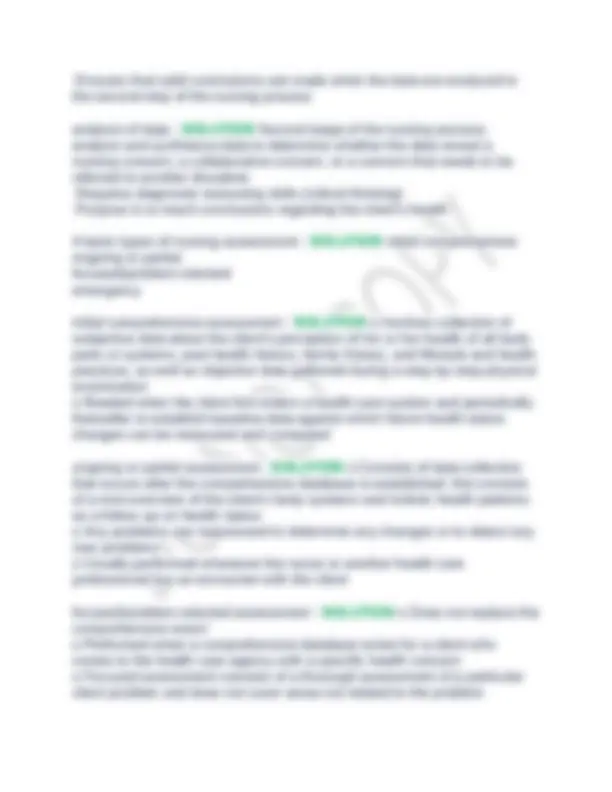
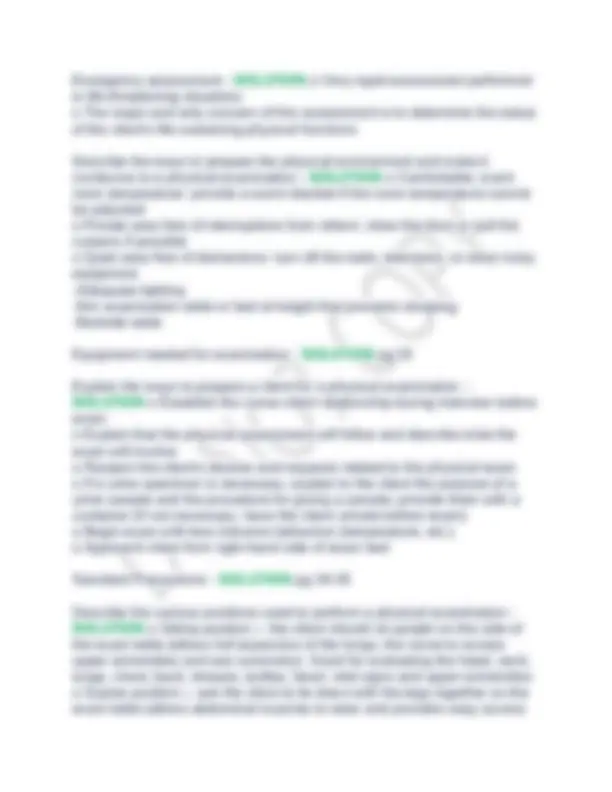
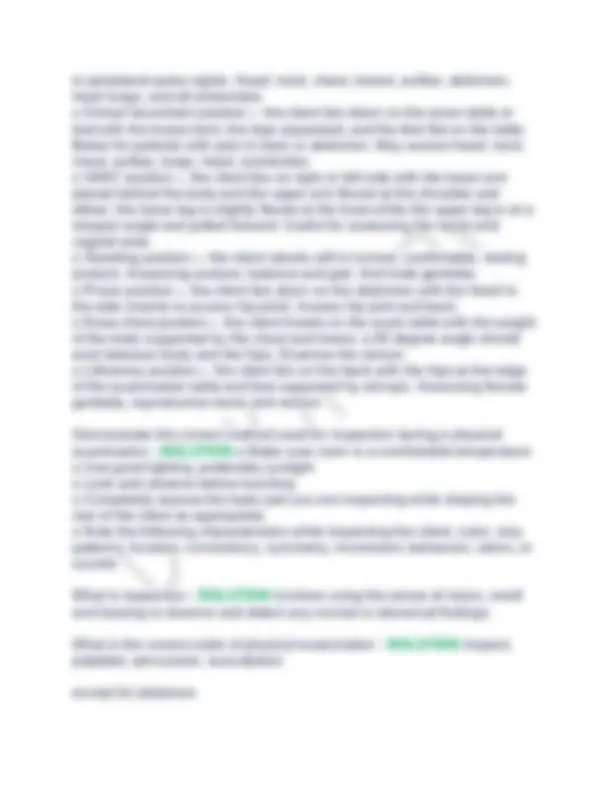
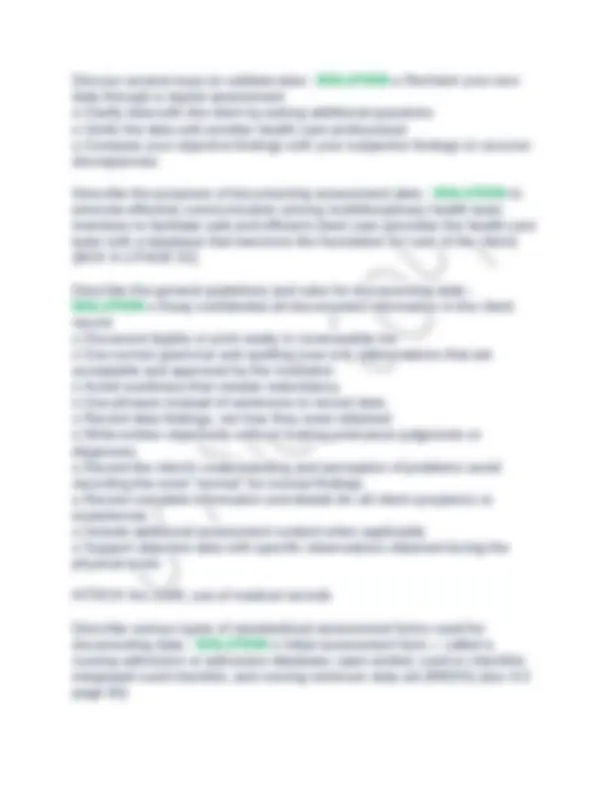
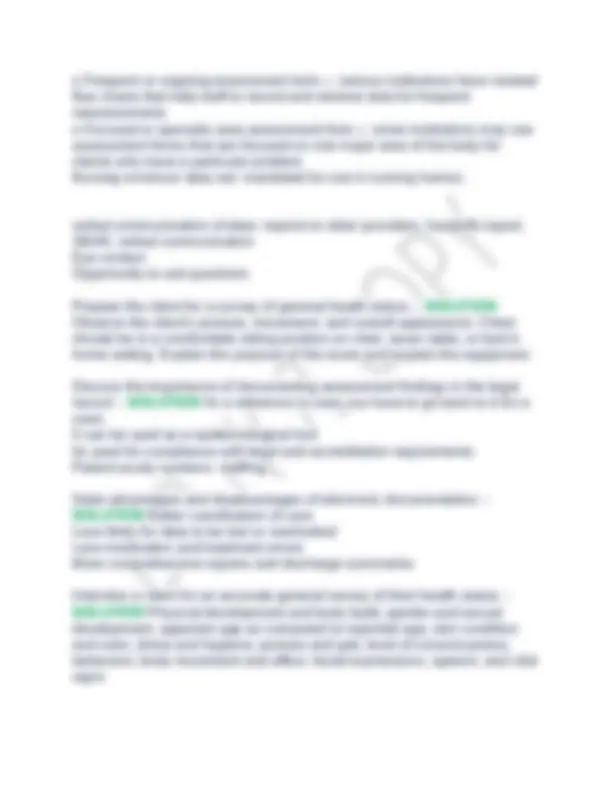
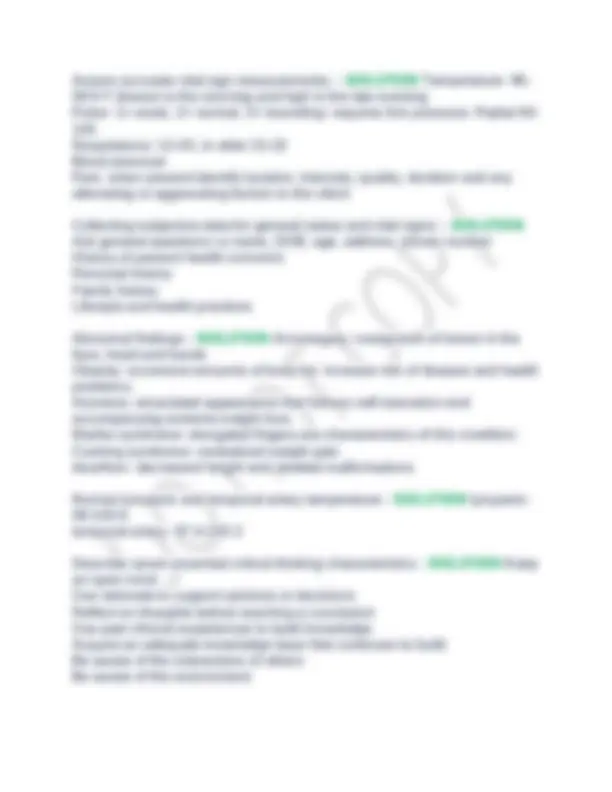
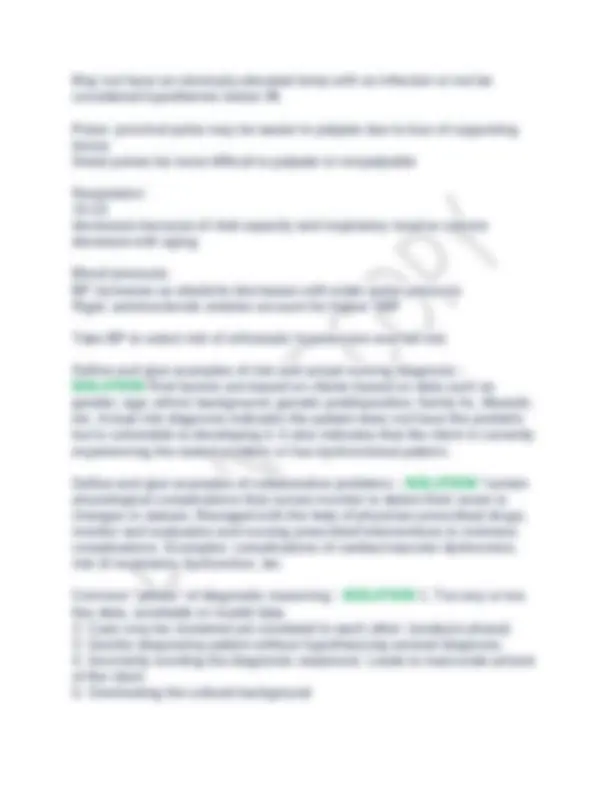
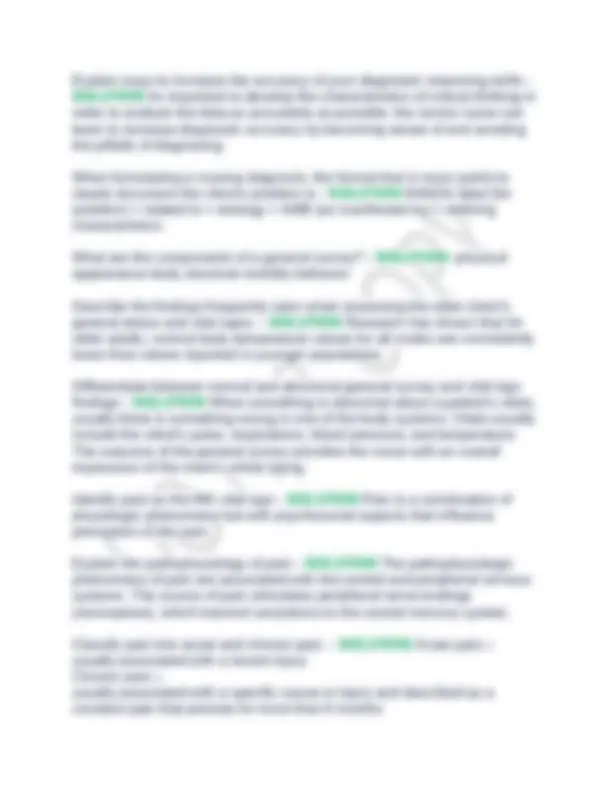
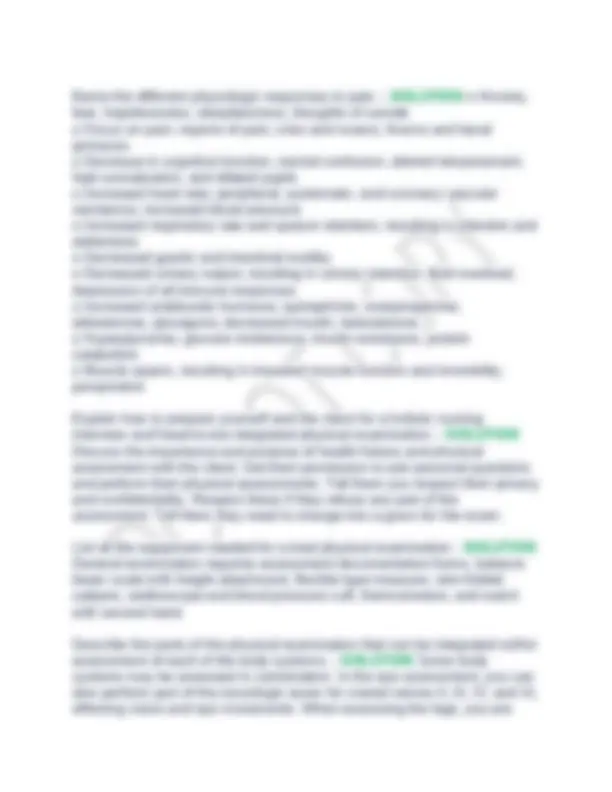
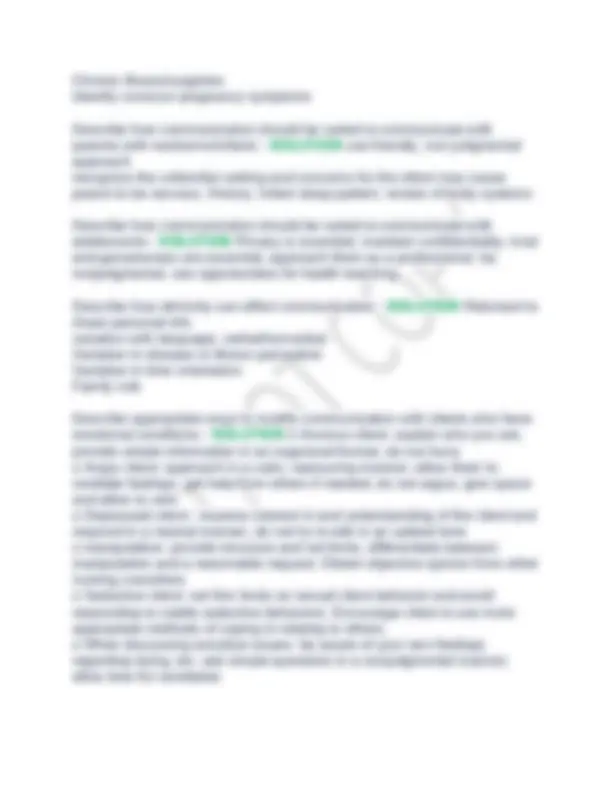
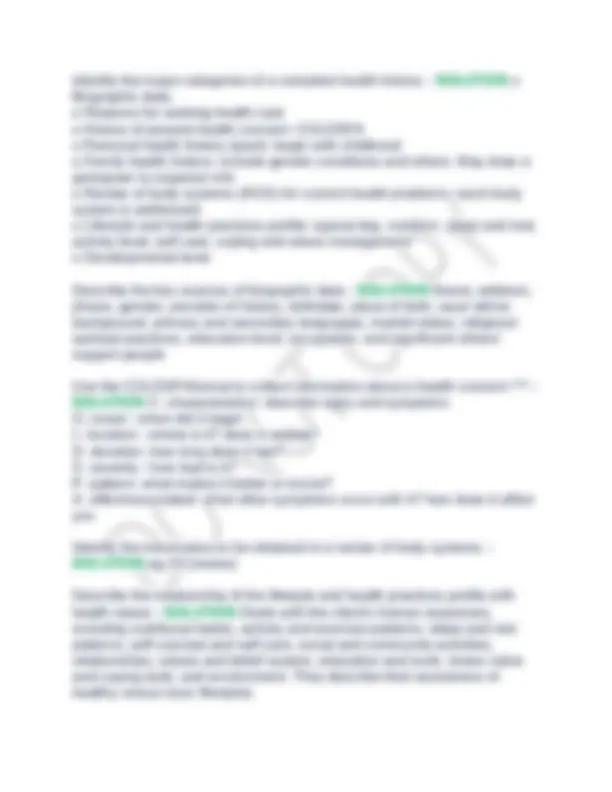
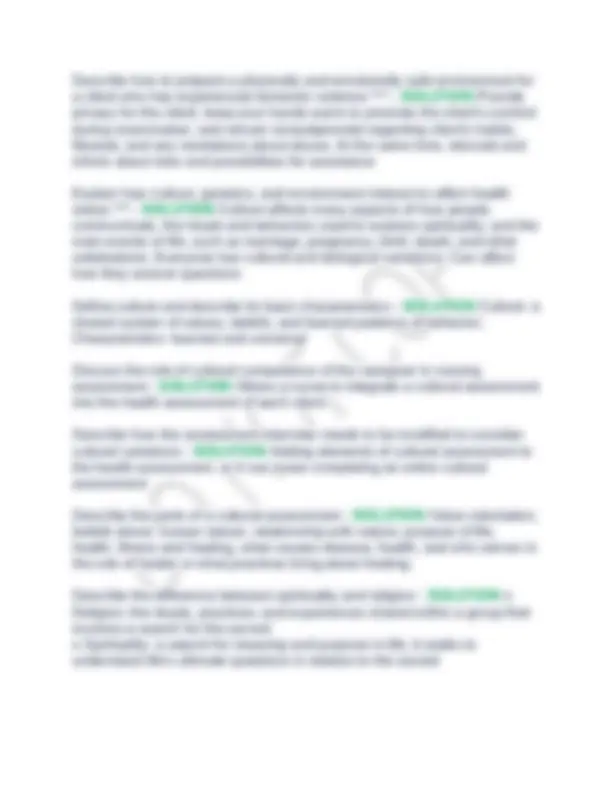
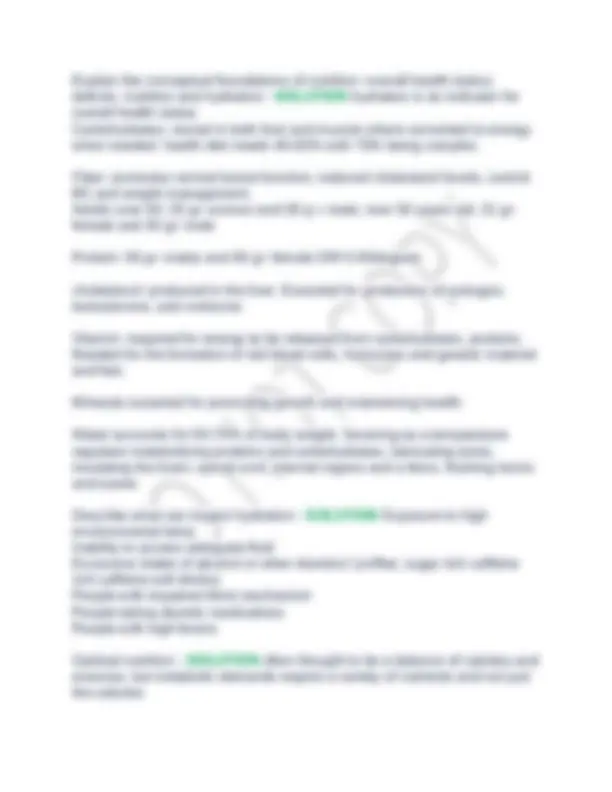
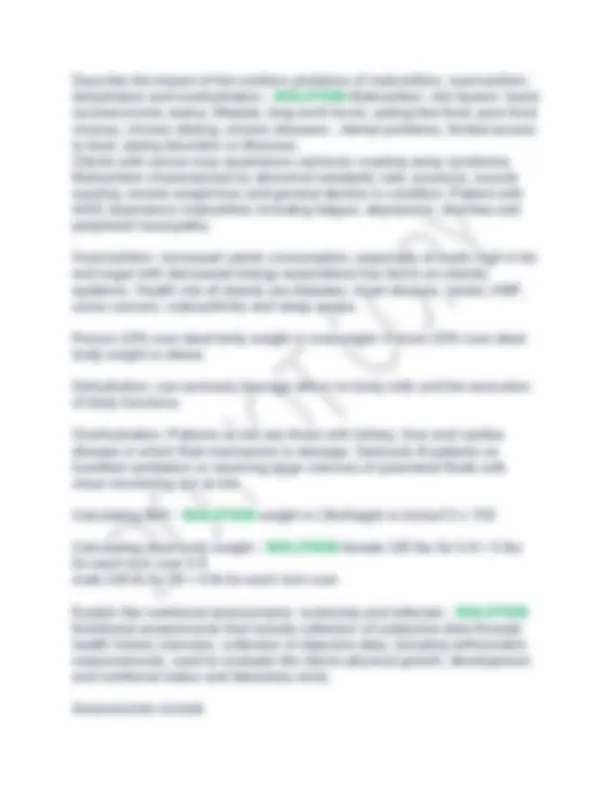
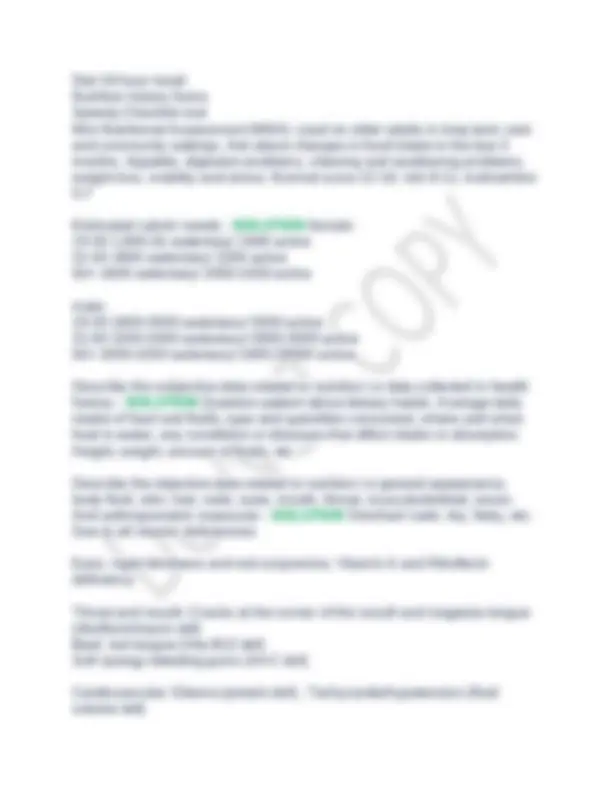
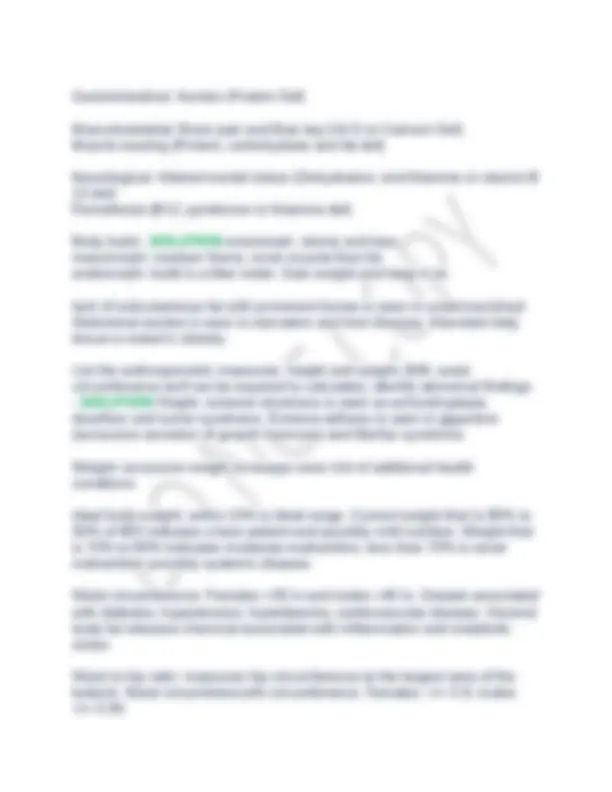
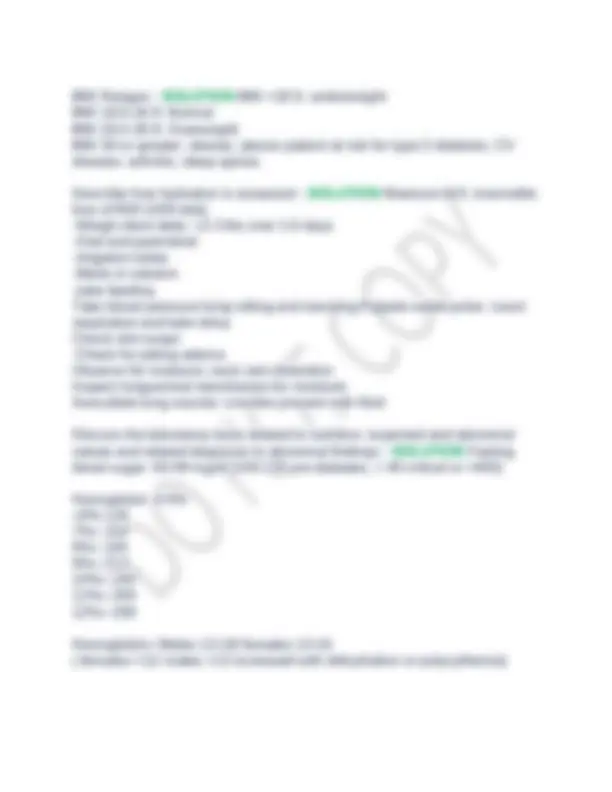
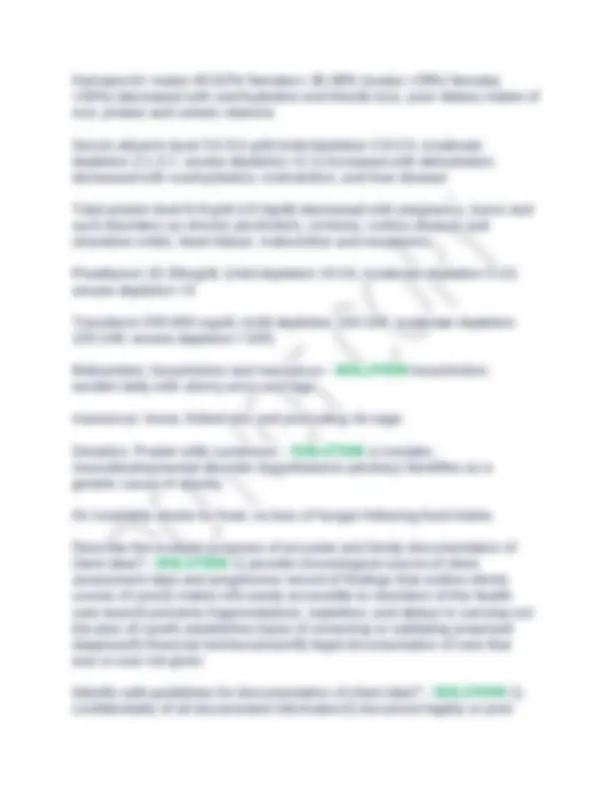
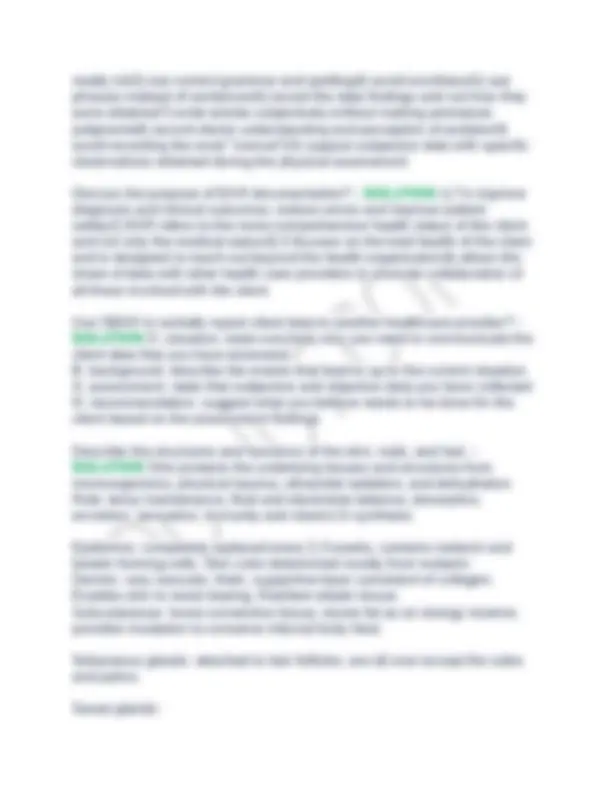
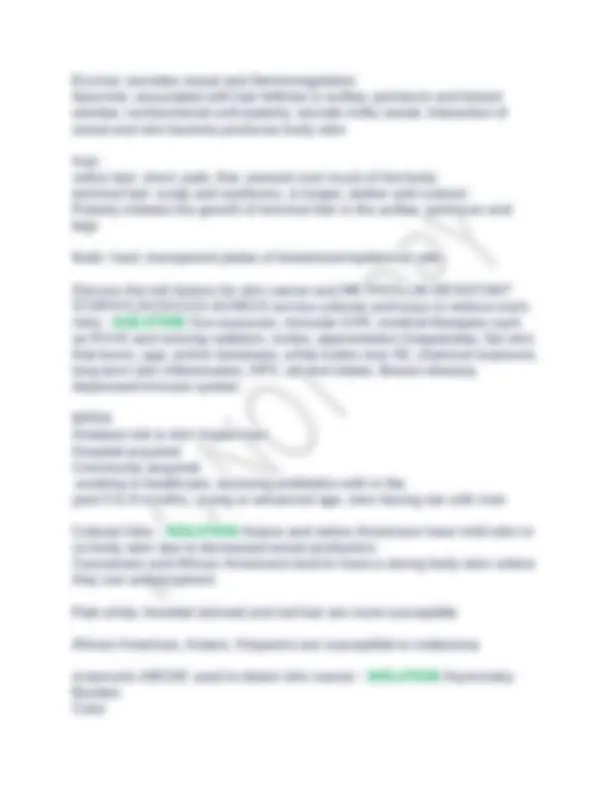
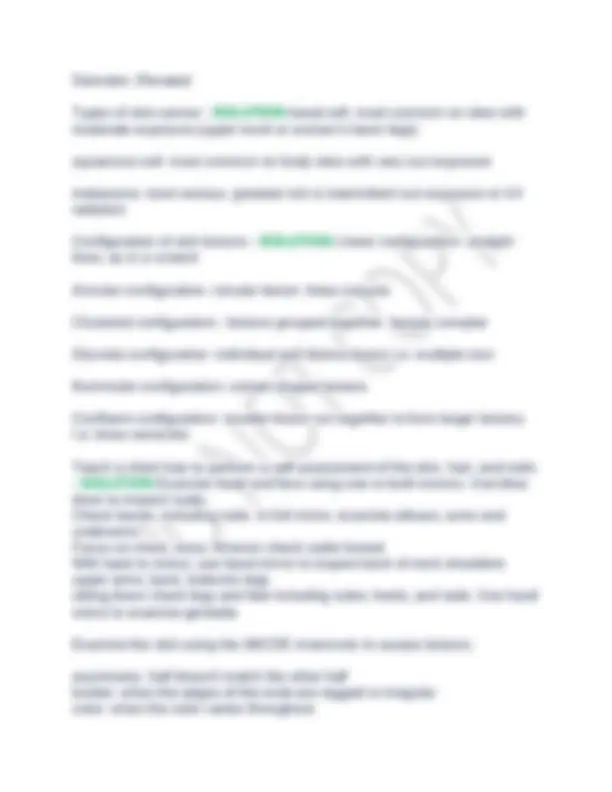

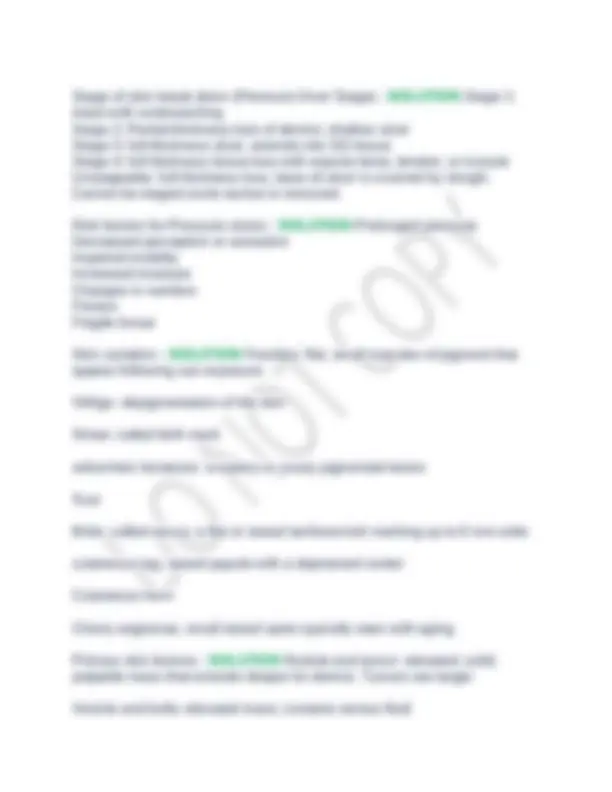
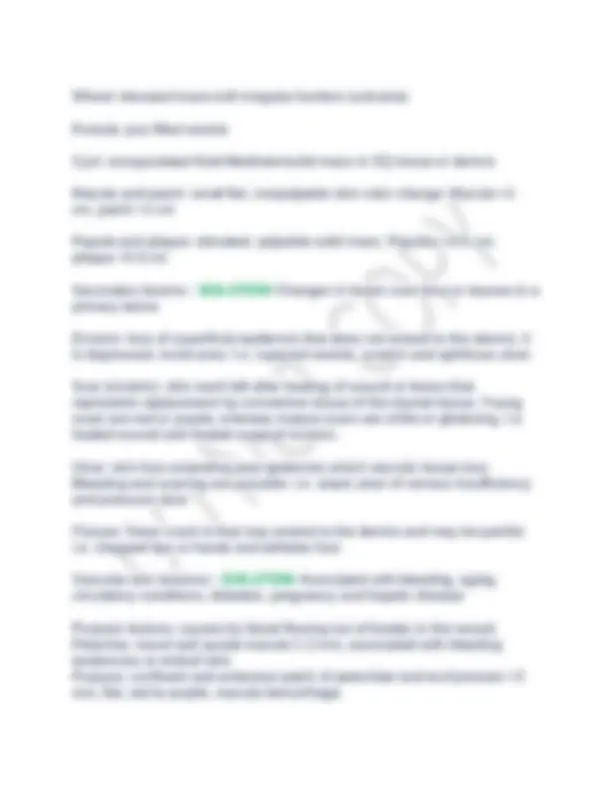
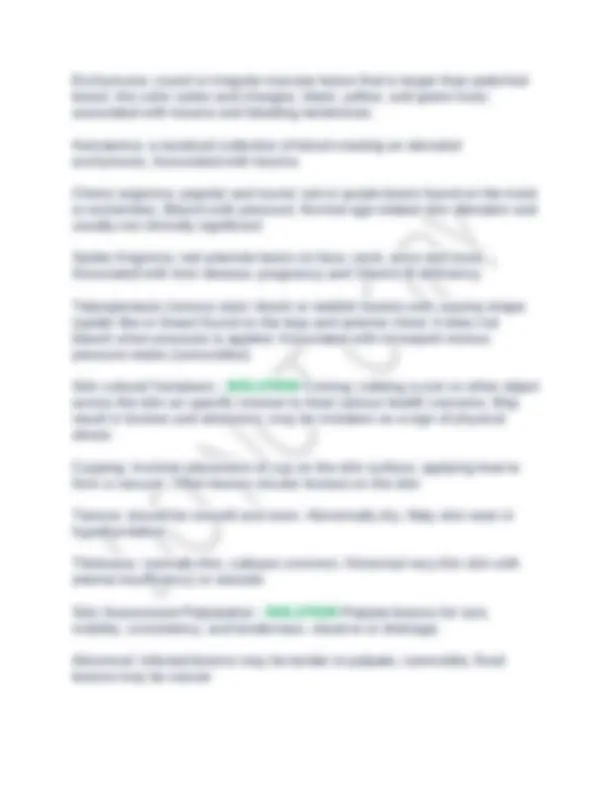
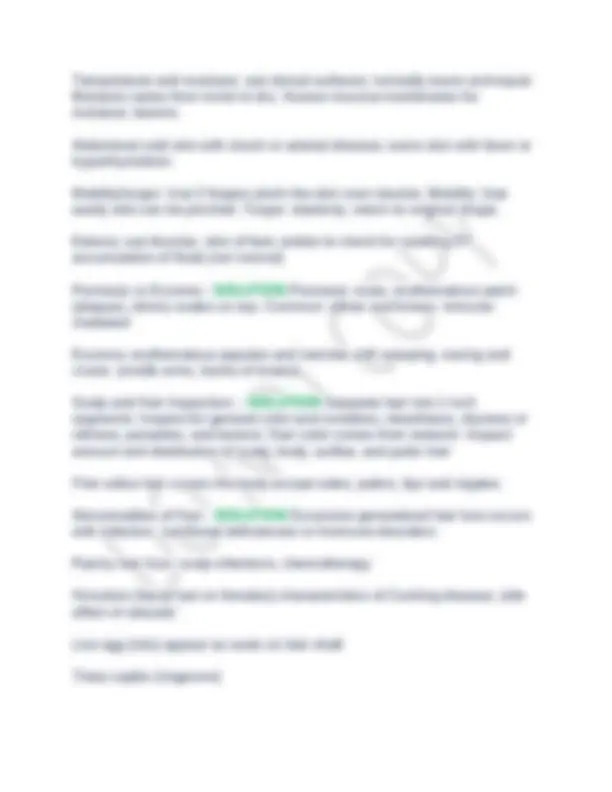
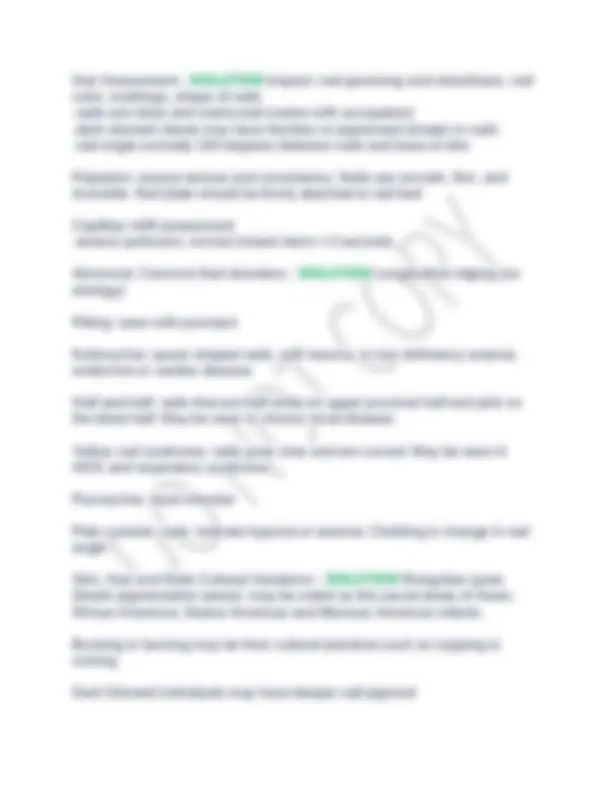
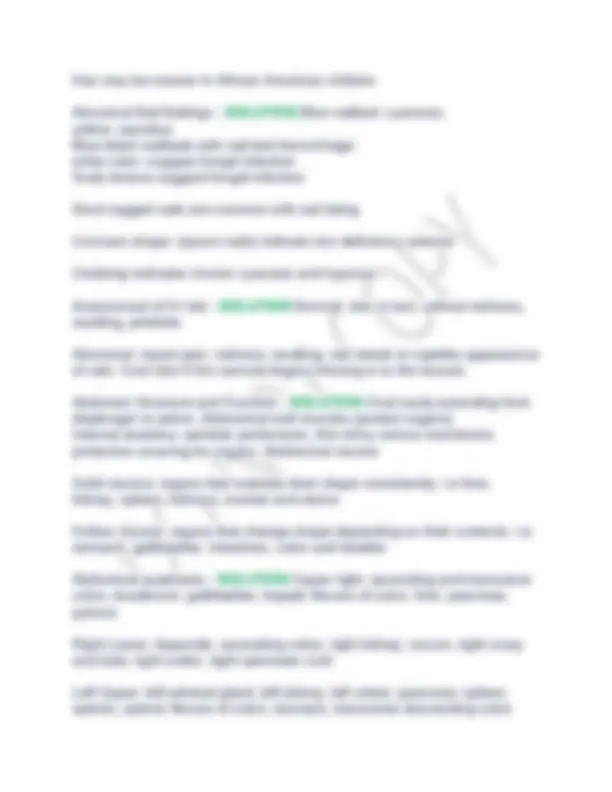
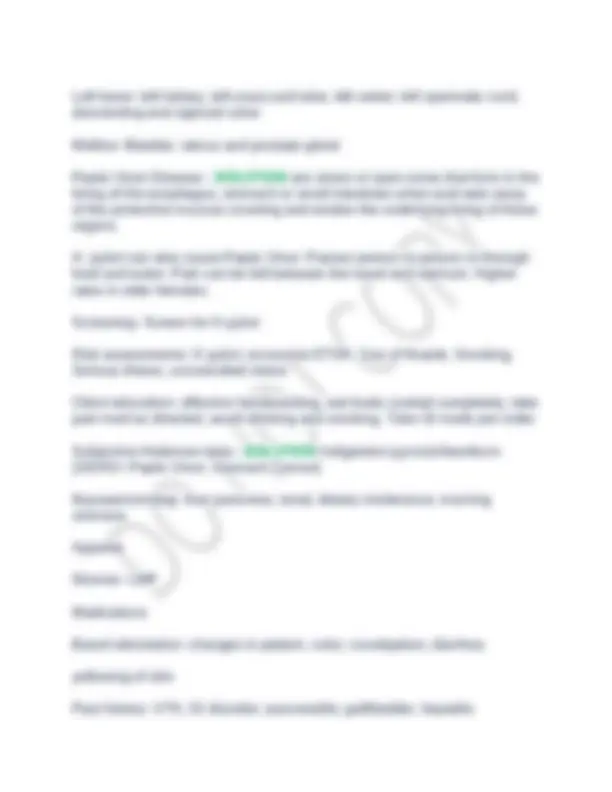
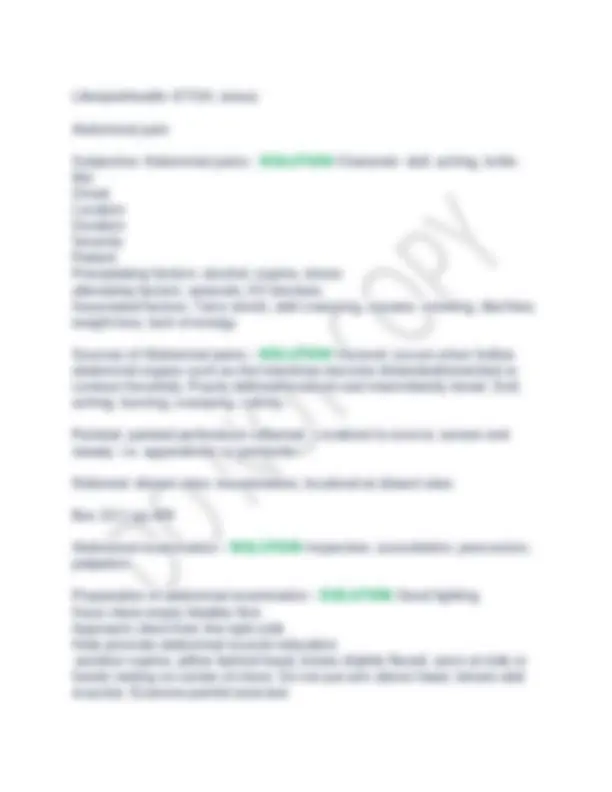
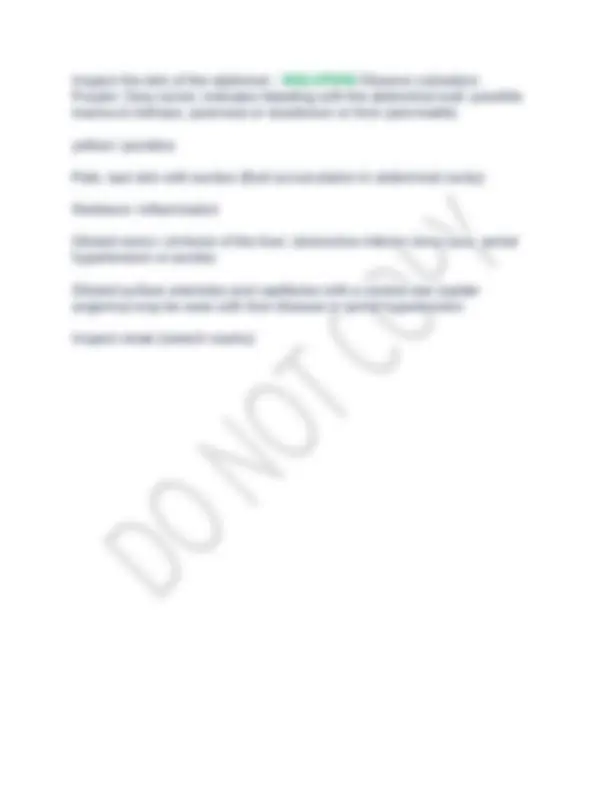


Study with the several resources on Docsity

Earn points by helping other students or get them with a premium plan


Prepare for your exams
Study with the several resources on Docsity

Earn points to download
Earn points by helping other students or get them with a premium plan
Community
Ask the community for help and clear up your study doubts
Discover the best universities in your country according to Docsity users
Free resources
Download our free guides on studying techniques, anxiety management strategies, and thesis advice from Docsity tutors
A comprehensive overview of the assessment phase in the nursing process. It explains the significance of collecting both subjective and objective data, the importance of validating and documenting data, and the role of assessment in making nursing judgments. It also covers various methods for data collection and ways to ensure data accuracy.
Typology: Exams
1 / 39

This page cannot be seen from the preview
Don't miss anything!
































Differentiate between a holistic nursing assessment and a physical medical assessment - SOLUTION Holistic→ the nurse collects physiologic, psychological, sociocultural, developmental, and spiritual data ABOUT the client Physical→ Less focus may be placed on psychological, sociocultural, or spiritual well-being. Also focus primarily on patient's musculoskeletal system and the effects on ability to perform activities of daily living. Explain how assessment skills are needed for every situation the nurse encounters. - SOLUTION If data collection is inadequate or inaccurate, incorrect nursing judgments may be made that adversely affect the remaining phases of the process Describe how assessment fits into the total nursing process - SOLUTION Assessment is the first and most critical phase of the nursing process. If data collection is inaccurate or inadequate, incorrect judgments might be made that affect the remaining phases of the process. Assessment is ongoing and continuous throughout all the phases of the nursing process. List and describe the steps of the nursing process - SOLUTION • Assessment→ collecting subjective data and objective data
knowledge, past experiences, intuition, and cognitive abilities to formulate conclusions or diagnosis. Determine your own ability to think critically. - SOLUTION Have you collected all of the information? Can you support your opinion or comments with data, rationale, and literature? Have you explored or considered alternatives? Can you distinguish better fact, opinion, cur or inference. Can you validate your information and judgements with experts in the field? Do you use past knowledge/experiences to analyze data? Do you try to avoid basis Could you be wrong What are the steps of health assessment - SOLUTION Subjective data Objective data Validation of data Documentation of data subjective data collection - SOLUTION sensations or symptoms, feelings, perceptions, desires, preferences, beliefs, ideas, values, and personal information that can be elicited and verified only by the client objective data collection - SOLUTION - Objective data collection: physical characteristics, body functions, appearance, behavior, measurements, and results of lab testing General observation and health documents Define validation of data - SOLUTION process of confirming or verifying that the subjective and objective data you have collected are reliable and accurate. Describe the steps of the validation process. - SOLUTION decide if the data requires validation determine ways to validate Identify gaps/missing data documentation of data - SOLUTION forms the database of for the entire nursing process and provides data for all other members of the health care team
Emergency assessment - SOLUTION o Very rapid assessment performed in life-threatening situations o The major and only concern of this assessment is to determine the status of the client's life-sustaining physical functions Describe the ways to prepare the physical environment and make it conducive to a physical examination - SOLUTION o Comfortable, warm room temperature: provide a warm blanket if the room temperature cannot be adjusted o Private area free of interruptions from others: close the door or pull the curtains if possible o Quiet area free of distractions: turn off the radio, television, or other noisy equipment -Adequate lighting -firm examination table or bed at height that prevents stooping. -Bedside table Equipment needed for examination - SOLUTION pg 32 Explain the ways to prepare a client for a physical examination. - SOLUTION o Establish the nurse-client relationship during interview before exam o Explain that the physical assessment will follow and describe what the exam will involve o Respect the client's desires and requests related to the physical exam o If a urine specimen is necessary, explain to the client the purpose of a urine sample and the procedure for giving a sample; provide them with a container (if not necessary, have the client urinate before exam) o Begin exam with less intrusive behaviors (temperature, etc.) o Approach client from right-hand side of exam bed Standard Precautions - SOLUTION pg 34- Describe the various positions used to perform a physical examination - SOLUTION o Sitting position→ the client should sit upright on the side of the exam table (allows full expansion of the lungs, the nurse to access upper extremities and see symmetry). Good for evaluating the head, neck, lungs, chest, back, breasts, axillae, heart, vital signs and upper extremities o Supine position→ ask the client to lie down with the legs together on the exam table (allows abdominal muscles to relax and provides easy access
to peripheral pulse sights. Head, neck, chest, breast, axillae, abdomen, heart lungs, and all extremities o Dorsal recumbent position→ the client lies down on the exam table or bed with the knees bent, the legs separated, and the feet flat on the table. Better for patients with pain in back or abdomen. May assess head, neck, chest, axillae, lungs, heart, extremities o SIMS' position→ the client lies on right or left side with the lower arm placed behind the body and the upper arm flexed at the shoulder and elbow; the lower leg is slightly flexed at the knee while the upper leg is at a sharper angle and pulled forward. Useful for assessing the rectal and vaginal area. o Standing position→ the client stands still in normal, comfortable, resting posture. Assessing posture, balance and gait. And male genitalia. o Prone position→ the client lies down on the abdomen with the head to the side (mainly to access hip joint). Assess hip joint and back. o Knee-chest position→ the client kneels on the exam table with the weight of the body supported by the chest and knees; a 90 degree angle should exist between body and the hips. Examine the rectum. o Lithotomy position→ the client lies on the back with the hips at the edge of the examination table and feet supported by stirrups. Assessing female genitalia, reproductive tracts and rectum. Demonstrate the correct method used for inspection during a physical examination - SOLUTION o Make sure room is a comfortable temperature o Use good lighting, preferably sunlight o Look and observe before touching o Completely expose the body part you are inspecting while draping the rest of the client as appropriate o Note the following characteristics while inspecting the client: color, size, patterns, location, consistency, symmetry, movement, behaviors, odors, or sounds What is inspection - SOLUTION involves using the sense of vision, smell and hearing to observe and detect any normal or abnormal findings. What is the correct order of physical examination - SOLUTION Inspect, palpitate, percussion, auscultation except for abdomen
the direct tapping of a body part with one or two fingertips to elicit possible tenderness. Sinuses Blunt percussion→ used to detect tenderness over organs by placing one hand flat on the body surface and using the fist of the other hand to strike the back of the hand flat on the body surface. Kidneys Indirect percussion→ the most commonly used method of percussion. The tapping produces a sound or tone that varies with the density of underlying structures. As density increases, the sound of the tone becomes quieter. Solid tissue produces a soft sound, fluid produces a louder tone, and air produces an even louder tone. (Percussion notes) Lungs What are the percussion sounds - SOLUTION Resonance: hollow sound heard over normal lungs Tympany: drum-like sound over gastric bubble (normal sound)Dullness: thud-like sound over organs (normal, pleural effusion (abnormal) Flatness: Flat sound heard over bone or muscle What is auscultation - SOLUTION using a stethoscope to listen to sounds not audible to the human ear. Classified according to the intensity, pitch, duration, and quality of the sound. Explain the correct use of a stethoscope and the purpose of the bell and the diaphragm - SOLUTION The stethoscope is used to listen for body sounds that cannot ordinarily be heard without auscultation. Place the earpieces into the outer ear canal. Angle the binaurals down toward your nose. The diaphragm is used to detect high-pitched sounds. Use the bell to detect low-pitched sounds. Describe conditions or situations that require data to be rechecked and validated - SOLUTION o Discrepancies or gaps between the subjective and objective data o Discrepancies or gaps between what the client says at one time versus another time o Findings that are highly abnormal and/or inconsistent with other findings
Discuss several ways to validate data - SOLUTION o Recheck your own data through a repeat assessment o Clarify data with the client by asking additional questions o Verify the data with another health care professional o Compare your objective findings with your subjective findings to uncover discrepancies Describe the purposes of documenting assessment data - SOLUTION to promote effective communication among multidisciplinary health team members to facilitate safe and efficient client care (provides the health care team with a database that becomes the foundation for care of the client) (BOX 4-1 PAGE 52) Describe the general guidelines and rules for documenting data - SOLUTION o Keep confidential all documented information in the client record o Document legibly or print neatly in nonerasable ink o Use correct grammar and spelling (use only abbreviations that are acceptable and approved by the institution o Avoid wordiness that creates redundancy o Use phrases instead of sentences to record data o Record data findings, not how they were obtained o Write entries objectively without making premature judgments or diagnoses o Record the client's understanding and perception of problems avoid recording the word "normal" for normal findings o Record complete information and details for all client symptoms or experiences o Include additional assessment content when applicable o Support objective data with specific observations obtained during the physical exam HITECH Act 2009, use of medical records Describe various types of standardized assessment forms used for documenting data - SOLUTION o Initial assessment form→ called a nursing admission or admission database; open-ended, cued or checklist, integrated cued checklist, and nursing minimum data set (NMDS) (box 4- page 56)
Assess accurate vital sign measurements. - SOLUTION Temperature- 96- 99.9 F (lowest in the morning and high in the late evening. Pulse- 1+ weak, 2+ normal, 3+ bounding- requires firm pressure. Radial 60- 100 Respirations- 12-20, in older 15- Blood pressure Pain- when present identify location, intensity, quality, duration and any alleviating or aggravating factors to the client. Collecting subjective data for general status and vital signs: - SOLUTION Ask general questions i.e name, DOB, age, address, phone number History of present health concerns Personal history Family history Lifestyle and health practices Abnormal findings - SOLUTION Acromegaly- overgrowth of bones in the face, head and hands Obesity- excessive amounts of body fat. increase risk of disease and health problems. Anorexia- emaciated appearance that follows self-starvation and accompanying extreme weight loss. Marfan syndrome- elongated fingers are characteristics of this condition. Cushing syndrome- centralized weight gain dwarfism- decreased height and skeletal malformations Normal tympanic and temporal artery temperature - SOLUTION tympanic- 98-100. temporal artery- 97.4-100. Describe seven essential critical thinking characteristics - SOLUTION Keep an open mind Use rationale to support opinions or decisions Reflect on thoughts before reaching a conclusion Use past clinical experiences to build knowledge Acquire an adequate knowledge base that continues to build Be aware of the interactions of others Be aware of the environment
Axillary and rectal temperature measurement - SOLUTION axillary- 95.6- 98.5 (1 degree lower than oral) Rectal- 0.7-1 degree higher than normal oral temp List the seven distinct steps used in this textbook to perform data analysis - SOLUTION 1. Identify strengths and abnormal data
May not have an obviously elevated temp with an infection or not be considered hypothermic below 96 Pulse: proximal pulse may be easier to palpate due to loss of supporting tissue Distal pulses be more difficult to palpate or nonpalpable Respiration: 15- decreases because of vital capacity and inspiratory reserve volume decrease with aging. Blood pressure: BP increases as elasticity decreases with wider pulse pressure Rigid, arteriosclerotic arteries account for higher SBP Take BP to select risk of orthostatic hypotension and fall risk. Define and give examples of risk and actual nursing diagnosis - SOLUTION Risk factors are based on clients based on data such as gender, age, ethnic background, genetic predisposition, family hx, lifestyle, etc. Actual risk diagnosis indicates the patient does not have the problem but is vulnerable to developing it. It also indicates that the client is currently experiencing the stated problem or has dysfunctional pattern. Define and give examples of collaborative problems - SOLUTION "certain physiological complications that nurses monitor to detect their onset or changes in statues. Managed with the help of physician prescribed drugs, monitor and evaluation and nursing prescribed interventions to minimize complications. Examples: complications of cardiac/vascular dysfunction, risk of respiratory dysfunction, etc. Common "pitfalls" of diagnostic reasoning - SOLUTION 1. Too any or too few data, unreliable or invalid data
Explain ways to increase the accuracy of your diagnostic reasoning skills - SOLUTION Its important to develop the characteristics of critical thinking in order to analyze the data as accurately as possible. the novice nurse can learn to increase diagnostic accuracy by becoming aware of and avoiding the pitfalls of diagnosing. When formulating a nursing diagnosis, the format that is most useful to clearly document the client's problem is - SOLUTION NANDA label (for problem) + related to + etiology + AMB (as manifested by) + defining characteristics. What are the components of a general survey? - SOLUTION -physical appearance-body structure-mobility-behavior Describe the findings frequently seen when assessing the older client's general status and vital signs. - SOLUTION Research has shown that for older adults, normal body temperature values for all routes are consistently lower than values reported in younger populations. Differentiate between normal and abnormal general survey and vital sign findings - SOLUTION When something is abnormal about a patient's vitals, usually there is something wrong in one of the body systems. Vitals usually include the client's pulse, respirations, blood pressure, and temperature. The outcome of the general survey provides the nurse with an overall impression of the client's whole being. Identify pain as the fifth vital sign - SOLUTION Pain is a combination of physiologic phenomena but with psychosocial aspects that influence perception of the pain. Explain the pathophysiology of pain - SOLUTION The pathophysiologic phenomena of pain are associated with the central and peripheral nervous systems. The source of pain stimulates peripheral nerve endings (nociceptors), which transmit sensations to the central nervous system. Classify pain into acute and chronic pain. - SOLUTION Acute pain→ usually associated with a recent injury Chronic pain→ usually associated with a specific cause or injury and described as a constant pain that persists for more than 6 months
also noting the skin, peripheral vascular system, musculoskeletal system, and neurologic system Describe the three phases of an interview - SOLUTION o Introductory o Working o Summary and closing phases Introductory phase of an interview - SOLUTION o Introductory→ After introducing themselves, the nurse explains the purpose of the interview, discusses the types of questions that will be asked, explains the reason for taking notes, and assures the client that confidential information will remain confidential. Make sure client has privacy and is comfortable. Develop trust and rapport. Working phase of an interview - SOLUTION o Working→ The nurse elicits the client's comments about major biographic data, reasons for seeking care, history of present health concerns, lifestyle and health practices, and developmental level. Listen and collaborate to find the problem. Summary and closing phases of an interview - SOLUTION o Summary and closing phases→ The nurse summarizes information obtained during working phase and validates problems and goals with the client. Identifies and discusses possible plans to resolve the problem. Describe the use of nonverbal communication during an interview - SOLUTION Appearance- demeanor- professional posture- at eye level with the patient facial expressions- neutral and friendly *Attitude- nonjudgmental silence- allows you and the patient to reflect and organize thoughts. *listening- you need to maintain good eye contact, smile, or display an open, appropriate facial expression. Must be able to keep an open mind. Describe the use of effective verbal communication during a client interview
laundry list- provide the patient with a list of words to choose from in describing symptoms, conditions, or feelings. rephrasing- rephrase information client provided. Helps you clarify information the client has stated. well-placed phrases- encourages client verbalization by using well placed phrases such as "yes", "I agree" to encourage them to continue inferring- helps elicit most accurate data possible from the patient providing information- provide information as a question and concerns arise. Describe the types of verbal communication that should be avoided in client interviews - SOLUTION Biased or leading questions- avoid using biased or leading questions. rushing through the interview- don't ask questions on top of questions reading the questions- avoid reading questions False reassurance unwanted advice using authority using professional jargon Talking too much Interrupting using "why" questions Describe the types of nonverbal communication that should be avoided in client interviews - SOLUTION Excessive or insufficient eye contact- avoid extremes in eye contact. Distraction and distance - avoid being occupied with something else while you are asking questions during the interview. No more than 2-3 feet distance. Standing- avoid standing while the client is seated during the interview Describe how communication should be varied to communicate with elderly clients - SOLUTION Assess hearing acuity, establish and maintain trust, privacy, and partnership, speak clearly and straightforward. Address formally, use open ended questions. Mental status, Falls, Weakness, urinary incontinence, bowel elimination, pain assessment and functional status Describe how communication should be varied to communicate with child bearing woman - SOLUTION Obtain accurate prenatal history
Identify the major categories of a complete health history - SOLUTION o Biographic data- o Reasons for seeking health care o History of present health concern- COLDSPA o Personal health history (past)- begin with childhood o Family health history- include genetic conditions and others. May draw a genogram to organize info o Review of body systems (ROS) for current health problems- each body system is addressed o Lifestyle and health practices profile- typical day, nutrition, sleep and rest, activity level, self care, coping and stress management o Developmental level Describe the key sources of biographic data - SOLUTION Name, address, phone, gender, provider of history, birthdate, place of birth, race/ ethnic background, primary and secondary languages, marital status, religious/ spiritual practices, education level, occupation, and significant others/ support people Use the COLDSPAformat to collect information about a health concern *** - SOLUTION C- characteristics- describe signs and symptoms O- onset - when did it begin L- location - where is it? does it radiate? D- duration- how long does it last? S- severity - how bad is it? P- pattern- what makes it better or worse? A- affect/associated- what other symptoms occur with it? how does it affect you Identify the information to be obtained in a review of body systems. - SOLUTION pg 23 (review) Describe the relationship of the lifestyle and health practices profile with health status - SOLUTION Deals with the client's human responses, including nutritional habits, activity and exercise patterns, sleep and rest patterns, self-concept and self-care, social and community activities, relationships, values and belief system, education and work, stress value and coping style, and environment. They describe their awareness of healthy versus toxic lifestyles.
Describe how to prepare a physically and emotionally safe environment for a client who has experienced domestic violence *** - SOLUTION Provide privacy for the client, keep your hands warm to promote the client's comfort during examination, and remain nonjudgmental regarding client's habits, lifestyle, and any revelations about abuse. At the same time, educate and inform about risks and possibilities for assistance Explain how culture, genetics, and environment interact to affect health status *** - SOLUTION Culture affects many aspects of how people communicate, the rituals and behaviors used to express spirituality, and the main events of life, such as marriage, pregnancy, birth, death, and other celebrations. Everyone has cultural and biological variations. Can affect how they answer questions Define culture and describe its basic characteristics - SOLUTION Culture: a shared system of values, beliefs, and learned patterns of behavior; Characteristics: learned and universal Discuss the role of cultural competence of the caregiver in nursing assessment - SOLUTION Allows a nurse to integrate a cultural assessment into the health assessment of each client. Describe how the assessment interview needs to be modified to consider cultural variations - SOLUTION Adding elements of cultural assessment to the health assessment, or it can mean completing an entire cultural assessment Describe the parts of a cultural assessment - SOLUTION Value orientation, beliefs about: human nature, relationship with nature, purpose of life, health, illness and healing, what causes disease, health, and who serves in the role of healer or what practices bring about healing. Describe the difference between spirituality and religion - SOLUTION o Religion: the rituals, practices, and experiences shared within a group that involves a search for the sacred. o Spirituality: a search for meaning and purpose in life; it seeks to understand life's ultimate questions in relation to the sacred